
Saint Olave's Grammar School




Can we use genetics to prevent or cure diseases?, by Sparsh Bhadauria 8B
Carbon, by Karthikeya Turlapati 8C
Common Cold, by Eshaan Sharma 8H Crystallisation, by SAIARPIT MISHRA 8L
The Ear, by Bavethran 8B
How Can Tardigrades Survive Ok? by Reyansh Gope, Mingyuan Mi and Sarthak Mishra 8H
How does a plane fly? by Dharav Dalal 7C
Living outside the Earth, by Karthikeya Turlapati, 8C
Nitinol, by Anuran Kajentheran, Dev Jain and Dharav Dalal 7C
Obesity, by Aryaman Sharma 7H Palaeontology, by Ahaan Sagar Psychology, by Jebishan Jeseeyas, Nikhil Gajavilli, Avy Gowda 7H Resuscitation, by Dharav Dalal 7C
The Science behind Maglev Trains, by Dion Cristo 8B Sound, by Ajay Raj
Space X NKC, by Sid Virmani 7H Space Race, by Sarthak Mishra 8H
The Survival of Tardigrades, by Vivaan Shanker
What Makes Plants So Important To Life On Earth? by Arjun Sharma, 7L
What we do to affect our world, by Hafid Mohamed 8H
Uses of Yeast, by Philip Kutenkov
This week we are proud to celebrate British Science Week. British Science Week is an incredibly important week as Science is everything. Without knowledge of Science, we will not be able to understand our world.
In this journal, our lower school will be showcasing various articles teaching us the art of science. These articles range from elements to animals to CPR to space, and are very interesting to read. Please be prepared to experience the


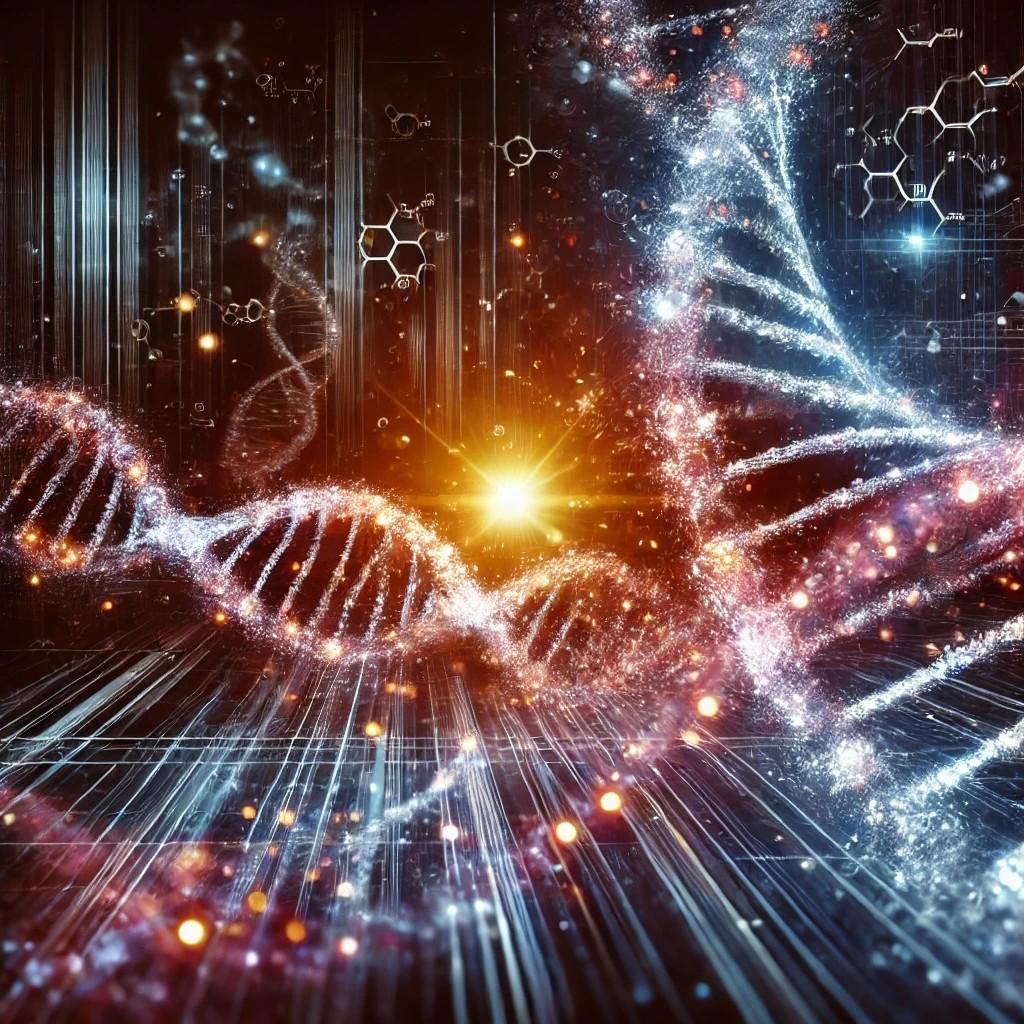

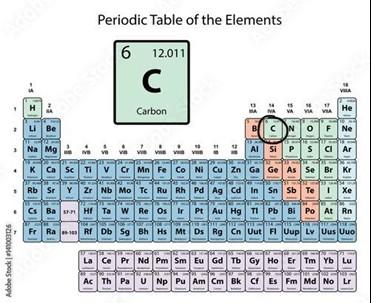
By Karthikeya Turlapati, 8C
Have you ever stopped to think about what connects everything around you? The food you eat, the air you breathe, the trees outside, and even the screen you’re reading this on all have one thing in common: carbon. It’s one of the most important elements in the universe and plays a vital role in life as we know it.
Carbon is a chemical element represented by the letter C on the periodic table, with an atomic number of 6. This means every carbon atom has six protons in its nucleus. But what makes carbon so special isn’t just its structure—it’s what it can do. Carbon atoms can bond with up to four other atoms at once, making it incredibly versatile. These bonds allow carbon to form a wide variety of molecules, from the simplest gas, carbon dioxide (CO₂), to the complex molecules in your DNA.
In fact, carbon is often called the “building block of life.” Every living thing, from the smallest bacteria to the tallest trees and even us humans, relies on carbonbased molecules. Proteins, fats, carbohydrates, and DNA are all built around carbon. Its ability to form long chains and rings makes it ideal for creating the molecules that make life possible. Without carbon, life as we know it wouldn’t exist.
But carbon isn’t just in living things. It’s a key player in the environment. You’ve probably heard of the carbon cycle, the process by which carbon moves through the Earth’s atmosphere, oceans, land, and living organisms. Plants use carbon dioxide during photosynthesis to produce food, and in turn, they release oxygen for us to breathe. The oceans absorb CO₂ from the atmosphere, and tiny marine organisms use it to build shells and skeletons. When they die, this carbon sinks to the ocean floor. Over millions of years, ancient plants and animals trapped carbon underground, creating fossil fuels like coal, oil, and natural gas.
Unfortunately, human activities have disrupted this natural cycle. By burning fossil fuels and cutting down forests, we’ve released large amounts of carbon dioxide into the atmosphere. This excess CO₂ traps heat, causing global warming and climate change. Rising temperatures, melting ice caps, extreme weather, and rising sea levels are just some of the consequences. Scientists and engineers are working hard to find solutions, like renewable energy, reforestation, and technologies to capture and store carbon.
•Fun facts
•Carbon isn’t just about the environment, thoughit’s also fascinating in other ways. Did you know that diamonds and pencil graphite are made of pure carbon? The difference lies in how the carbon atoms are arranged. In diamonds, the atoms are tightly bonded in a crystal structure, making them incredibly hard. In graphite the atoms are arranged in layers that easily slide over one another, which is why it works so well in pencils. Scientists have also engineered carbon nanotubes, tiny structures that are 100 times stronger than steel and have incredible potential for building futuristic materials.
•Another cool thing about carbon is Carbon-14, a radioactive isotope of the element used in carbon dating. Scientists use this technique to determine the age of ancient fossils and artifacts, helping us understand the history of life on Earth.
•Conclusion
•Carbon is truly amazing. It’s in the food we eat, the air we breathe, the things we use every day, and even the stars themselves. It brings immense potential for materials and technology of the future, and it’s being used to identify our planet’s past. The next time you take a deep breath or write with a pencil, take a moment to appreciate this incredible element and all that it does. Researching this topic connected me with such fascinating knowledge. I hope that reading this article does the same to you!


By Eshaan Sharma 8H
The common cold is an illness that nearly everyone has contracted in the fluctuation in temperatures. No human on earth has developed immunity against it though. Our bodies can develop immunity against other diseases and illnesses, but it cannot against the common cold. Chickenpox is caused by the varicella virus. It is also known as shingles. The virus causes a high fever, flu-like symptoms and red spots to appear on your body. What’s interesting is that after a person contracts it once or twice, you never get it again. This is because your body becomes immune to it. The acquired immune system creates antibodies to attach to foreign bacteria, viruses, fungi, etc. and eventually kill it. Specialized cells called B lymphocytes develop this protein. After someone is exposed to the virus, he/she does not contract it again because the antibodies recognise the foreign agent if it comes again at kills it. The acquired immune system develops over time as you get exposed to more toxins.

However, there’s a flaw in the immune system. Or that’s what you may think. You have had the common cold multiple times. But our body keeps contracting it again and again. Is our body not immune to it? Scientists and MedUni Vienna has run some tests and this and their conclusion is that our antibodies attack and attach to a part of the virus that does not kill it. The antibodies attach to the inside of the cell instead of the membrane of the cell. The


•Cilia and specialized cells in the trachea help to keep infectious bacteria and diseases from entering the lungs. Cilia wafts bacteria and viruses from entering the lungs and mucus traps the bacteria inside it so that when you blow your nose, the infection comes out in the mucus. However, as colds normally occur in winter, it makes it hard for the cilia and the mucus to do its job as we are breathing in cold air. This makes it easier for viruses to enter your body.
•It usually takes humans 5 days to develop antibodies against most foreign agents. However, the virus that causes the common cold is not very serious and will wear off on its own after some time. The virus does not die away completely though. It goes from body to body finding its next victim and that’s why it’s contagious. If it stays too long in one human body, it cannot survive and goes to someone else. This is why it’s contagious.
•Why can’t it survive in someone’s body?
•The common cold is caused by many viruses because of virus mutations. The most common cold cases are caused by the rhinovirus. When a form of the rhinovirus enters the body, the body becomes immune to that type of virus. However, there are many different variations of the virus and humans are not entirely immune to all different variants of the virus. Humans cannot change their DNA so they cannot change their qualities. Cold viruses can change it, which makes matters worse. They can mutate and change their qualities. Our body becomes immune to the initial form of the virus, but it takes time for it to become immune to the mutations. There are just so many mutations of it that it is impossible for us to be entirely immune to the common cold.


Doctors are unable to create a vaccine because there are many types of species and families of the virus. The most we can do is to make sure that we are hygienic. The virus can be present on any surface on our planet, and that is why we should wash our hands thoroughly to fully eradicate the virus. Some people have weakened immune systems which means that they must go to the hospital now and then to get advice from doctors.
If we did find a cure, would it actually be worth it?
Technology and science is constantly evolving. There is a chance that in the future, scientists will find a cure to the common cold. Would it be worth it though? Studies show that being exposed to the rhinovirus and the common cold can help to improve and strengthen our immune system to more serious viruses. I was reading the What If? Book by Randall Munroe found out that someone had a crazy idea that if all humans stayed away for several weeks, the common cold would be wiped out. This is true as the viruses would have nowhere to run to and die in our bodies, but for our future generations, their immune systems would be weakened, not to mention the people who would be born with a weakened immune system due to a disease or disability. What if? Also says that this has happened before in the islands of St Kilda north of Scotland. The common cold is useful although you might not think it is. There will be people who will take the vaccine though. What if? Does say though that people with weakened immune systems would be a hotspot for viruses and we would not eradicate the virus after all. They would pass on the virus to other hosts.
In conclusion, it is impossible for our bodies to be immune to the cold (as scientists say) , and if we do find a cure, it would not be worth it as colds help our immune system and rhinoviruses would still live and cause global annoyance. Instead of creating a cure for colds, I think they should create a cure for cancer. This is because on average, over 10 million people die each year of cancer, while nearly no-one or only a few hundred people die from the common cold. Cancer is a ferocious and scared disease, while the common cold is an unharmful illness and it wears away on its own.




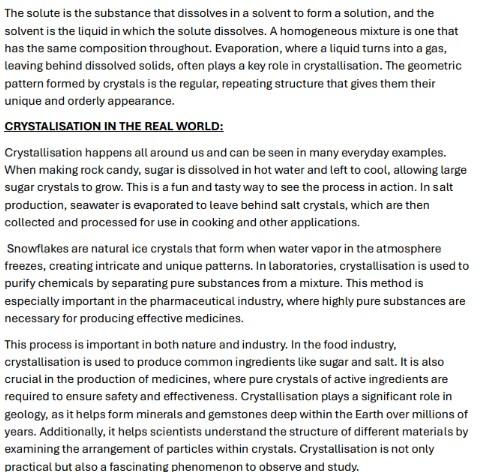




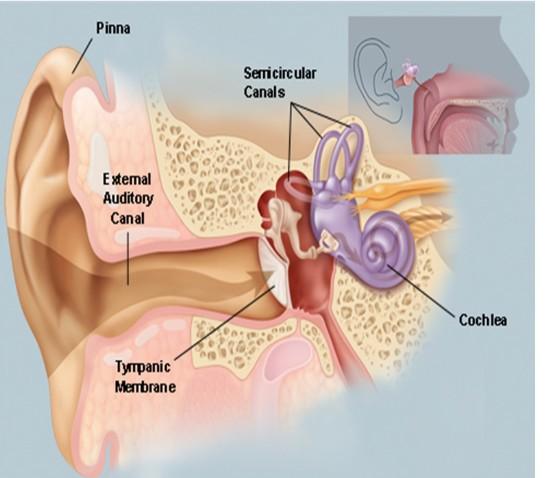


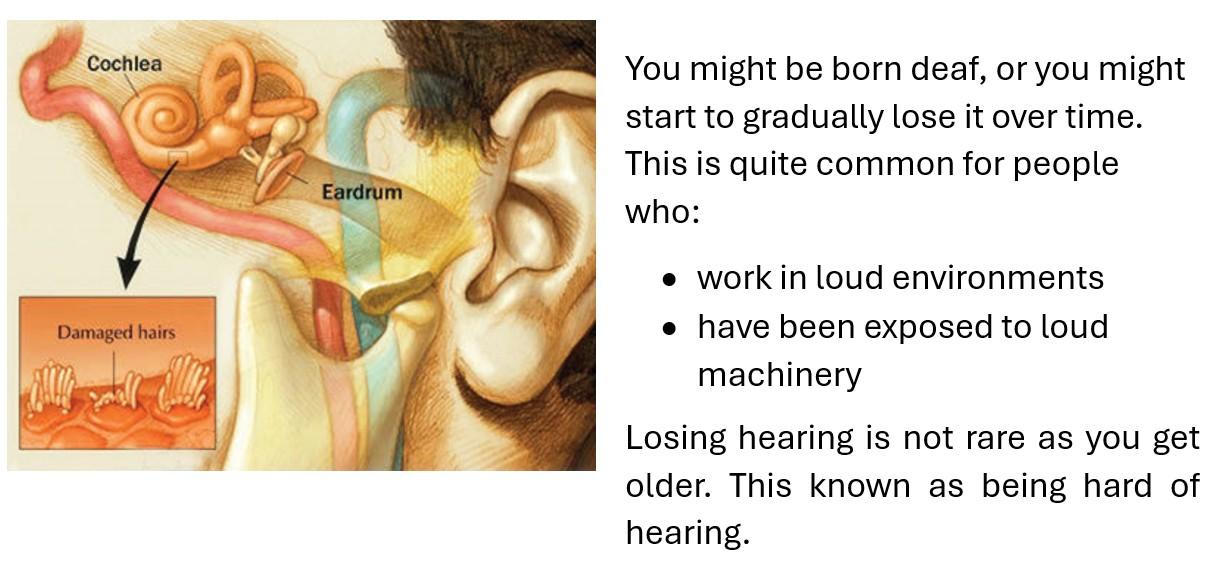
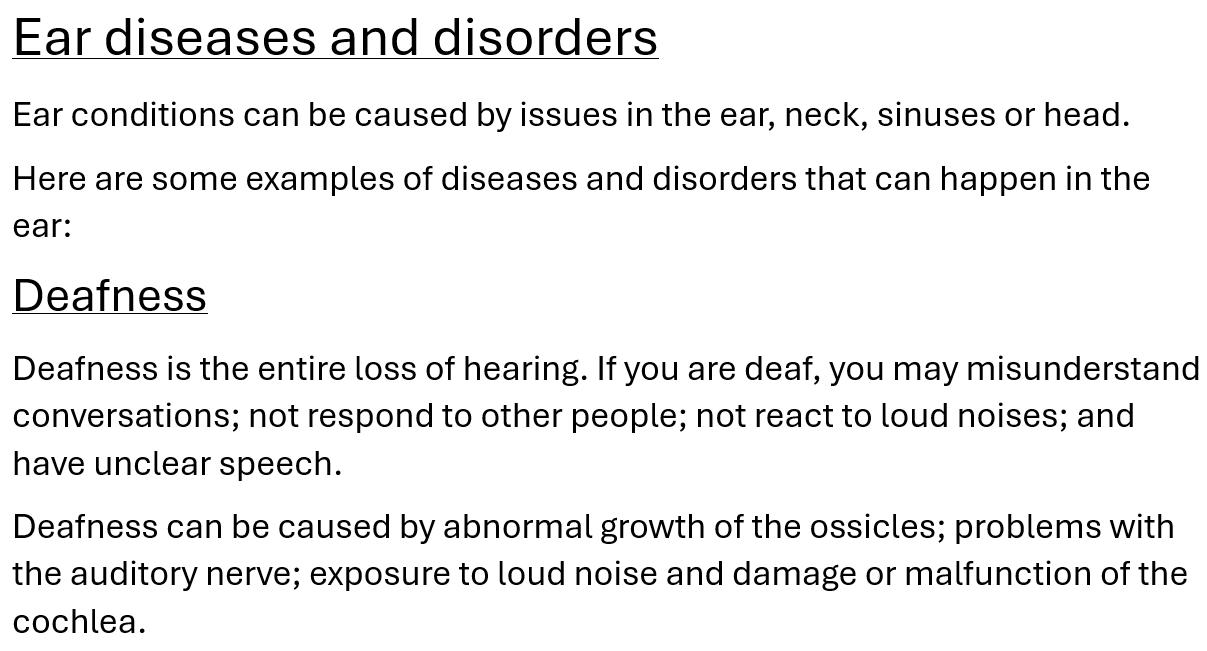





BY REYANSH GOPE,MINGYUAN
Water is a key ingredient to all life on earth, yet Tardigrades, tiny, eight legged animals, with immortality-like powers somehow endure despite being sapped of almost all their H2O. In this article, you will learn how exactly these extraordinary creatures live without water.
What are Tardigrades and where have they been spotted?
Eight legs, grasping claws, a body like a caterpillar, and a round mouth, probing for food. Is it an alien? A late-night monster movie? No, it is a tiny creature called a tardigrade, one of the most resilient animals on the planet! Tardigrades can be found almost everywhere on Earth, from the tropics to polar regions. They live in mosses, lichens, the roots of grasses, soil, or water sediments. The biggest tardigrades are only a little more than 1 millimeter (about 0.04 in) long.
Tardigrades survival

Despite their size, tardigrades are extremely tough and strong. Even though they need to be in water to be active, eat, and reproduce, they can survive for months or even years without a drop of water! A study by Oxford University and the Harvard-Smithsonian Center for Astrophysics (CfA) has shown that they can live for up to 30 years without food or water. They can survive intense heat and cold and can even survive being in outer space! Scientists keep learning more about how tardigrades perform such amazing feats of survival.
Tardigrades have been researched for centuries, since around 1773, when researcher and German zoologist J.A.E Goeze was observing them. He named it “Kleiner Wässerbar”, or for the non-Harvardians among you, the “little water bear”.
Despite their minuscule size, tardigrades still have predators. Amoebas, nematodes (roundworms with unsegmented, thread-like bodies) and even




The question we have now all been waiting for. How do tardigrades survive without water? Well, the truth is that Tardigrades have a trick they use to survive dry spells. They curl up into a small lump and push all the water out of their bodies. Scientists call this transformed tardigrade a tun. Then, when water is available again, the tardigrade rehydrates. There are over 1,400 species of tardigrades. Some are herbivores and some are predators. But most terrestrial tardigrades can form a tun. Scientists have conducted lots of experiments with different tardigrade species. But it’s hard to compare the results because the experiment methods can be quite different from each other. This is why they want to see how different species of tardigrades recover after being without water, using the same experimental conditions. Thank you for listening and hope you learnt why Tardigrades can survive without water.
By Dharav Dalal (7C)
Most people must have travelled in a flight. After all, there are over 8200 flights in the air at any given moment. However, have you ever thought about the physics behind how an aircraft flies? In this article, we will delve deeper into the procedures in which a plane takes off and the physics of its engines.
There are four main forces that keep a plane in the air: Lift, Weight, Thrust and Drag. Lift is the force that acts as a right angle to the direction of motion in the air. It is created by differences in air pressure. The second force, weight, is the force of gravity. It acts in a downward direction towards the centre of the Earth. The third force, drag, is an opposing force to the direction of motion. It is caused by friction with the particles in the air and differences in air pressure. The fourth and final force is thrust. Thrust is the force which propels the aircraft towards the direction of motion, and the engines provide the thrust.
Bernoulli’s Principle and Newton’s are key to the basic concepts of aviation. Bernoulli’s Principle states that if air is moving faster over the wing than it is moving under the wing, there would be a higher amount of pressure under the wing, which would create an upward force, lifting the plane off the ground. Newton’s Third Law states that if any action (force) is applied, there will be an equal but opposite force (the same force but in the opposite direction). Following this law, if the wings apply a downward force to the air, the equal but opposite force pushes the wings up. The lift here will keep the aircraft flying.
Similarly, in landing, the opposite happens, with the wings applying an upward force to the air, making the aircraft go down. Reducing the thrust will also help the aircraft slow down along with brakes and reverse thrust when it is on the runway. An aircraft typically has two different landing gears – the nose landing gear and main landing gear. For a good landing to happen, an aircraft must land closest to its centre of gravity,



There are a lot of diverse types of engines used in aircrafts, but they all use the same technology and principles. When the pilot puts the throttle up, the engines take in massive amounts of air and push it out through the back of the engines. Referring to Newton’s Third Law, as the air is pushed back, an equal but opposite force will push the place forward. For the aircraft to reverse, the engines reverse their function, and air is pushed out from the front of the engines, making the planes go back. Different sizes of aircraft use different types of engines, as a huge Boeing 747 would use a turbofan jet engine, while a considerably smaller Cessna 172 would use a propeller engine, capable of generating 145 horsepower.
I believe that the best design for designing an aircraft needs to be fuel efficient but have the same amount of range as today’s aircraft powered by jet fuel. Using composite materials, which are used extensively by the Boeing 787 Dreamliner, it reduces weight, making it extremely fuel-efficient. A design that I think will be the best going forward would be the blended wing design, as slender wings have been proved to increase efficiency by 50%, as proved by Airbus.
In conclusion, an aircraft uses many principles of physics to power itself through the sky. Alternatives to fuel, like hydrogen and electric aircraft, have been pitched out as ideas, but there has been no proper design or testing of any such aircraft. However, Airbus has been working hard to create a hydrogen-powered plane, which uses renewable resources to power an aircraft. Any plane design, however, will use these same concepts to bring the plane into the air and get the thrust needed for it to soar through the sky.
By Karthikeya Turlapati 8C

Hi there! I’m speaking to you from the year 3025, and I’ve recently moved to Mars from the Moon. Let me tell you about what it’s like living here and how humanity managed to make this incredible leap into space.
First, let’s talk about how we even got here. In my history lessons, we learnt that for a long time, scientists debated whether Mars could be a decent place for humans to live. And honestly, it’s not the easiest place to call home. Mars has very little oxygen and a thin atmosphere. In the early days, people needed oxygen tanks to survive, which took a lot of energy to maintain. Now, we’ve developed oxygen production systems that use Martian resources to supply breathable air for everyone. A key breakthrough was the development of MOXIE (Mars Oxygen In-Situ Resource Utilization Experiment), enabling large-scale

Gravity was another challenge. Mars has only about one-third of Earth’s gravity, which initially caused health problems like muscle weakening and brittle bones. Today, special exercise routines and gravityenhancing technology in our habitats keep our bodies healthy.
Water is a critical resource here. Initially, ice deposits on Mars were mined and melted for water. Now, advanced recycling systems ensure almost every drop of water is reused, making life sustainable on the Red Planet.
Let’s not forget the cold! Mars is about one and a half times farther from the Sun than Earth, with an average temperature of46°C (-51°F). Well-insulated homes and advanced heating systems now keep us comfortable.
Traveling here still takes about six months, just like it did 1000 years ago, in 2025. But once you arrive, you realize how far humanity has come to make this planet livable.

Before Mars, humans tried living on the Moon, which presented its own set of challenges, which I myself also experienced, and so I decided to move to Mars. There’s no atmosphere on the Moon, so breathing requires constant oxygen supplies. Temperature swings were extreme, ranging from248°C (-414°F) at night to 123°C (253°F) during the day. The Moon also faced constant meteorite impacts, making it risky to live there.
The Moon’s low gravity caused similar health issues to what we faced on Mars. Even so, it was an important stepping stone for humanity. Scientists developed oxygen extraction systems using lunar soil, a technology that later paved the way for life on Mars. The Moon also became a hub for space travel, helping us reach farther destinations like Mars and beyond.


1. Communications Delays and Blackouts:
- In the early days, communication between Earth and Mars was often disrupted because the Sun blocked signals. Today, a network of satellites around the Solar System keeps us connected. Laser communication systems make messages faster and clearer.
2. Life Support Systems:
- Our oxygen production systems extract air from Martian soil using advanced electrolysis. This oxygen is used for breathing and fuelling rockets. Water is sourced from underground ice and atmospheric moisture, with efficient recycling ensuring sustainability.
3. Energy Systems:
- Solar energy powers most of our systems on Mars, but dust storms can block sunlight for weeks. That’s why we also rely on nuclear power, with small modular reactors providing reliable backup energy.
4. Radiation Protection:
- Mars’ thin atmosphere doesn’t protect us from solar and cosmic radiation. Our habitats, built with regolith (sediment)covered domes and water-filled walls, effectively block harmful rays.
5. Transportation:
- Landing on Mars was challenging due to the thin atmosphere, which made slowing down spacecraft difficult. Engineers developed large decelerator systems to ensure safe landings. Surface vehicles adapted to Mars’ rugged terrain now transport people and goods efficiently.
6. Food Production:
- We grow crops in greenhouses using hydroponics and aeroponics. Martian soil has been enriched with nutrients to support agriculture, allowing us to produce fresh food locally.
7. Psychological Adaptation:
- Living so far from Earth can be isolating. Virtual reality helps us stay connected with loved ones and experience Earthlike environments. Community spaces and regular social activities maintain mental health.

Living on Mars is surreal. When I look out of my habitat’s window, I see a red desert stretching for miles. It’s amazing to think that a thousand years ago, humans were just dreaming about living here. Today, thriving communities with greenhouses, energy systems, and radiationprotected habitats make life not only possible but enjoyable.
Breathing here isn’t a problem anymore. Our oxygen systems extract air from the Martian soil, and this technology even fuels rockets. It’s incredible how far we’ve come.
The Moon remains important. It’s a hub for space tourism and mining rare Earth materials. Back in 2040, NASA began building homes on the Moon using 3D printers. Those first lunar houses were a big step toward everything we’ve achieved on Mars. DARPA’s lunar railroad, built in the mid-21st century, allowed people and resources to move across the Moon efficiently, paving the way for our advancements on Mars.
Living on Mars is a dream come true for humanity, but it’s also a testament to the immense human effort invested in making it possible. The Moon played a vital role in humanity’s journey to the stars. While Mars is now my home, I’ll always be amazed at how far humans have come since the 21st century.


Nitinol by Anuran Kajentheran, Dharav Dalal and Dev
Nitinol has always been regarded for its unique properties and characteristics. It has the special ability to change its shape . Nitinol is a compound metal of titanium and nickel. The metal is classified as a shape memory alloy (SMA). Apart from this it has a remarkably high corrosion resistance and pseudoplasticity. Due to these special properties of nitinol its use is commonly used in aerospace applications. One of its most innovative uses is the space wheel. NASA is utilising nitinol in its space exploration wheels to overcome the limitations of traditional rubber tires.
Shape memory alloys, such as nickel titanium, undergo a phase transformation in their crystal structure when cooled from the stronger, high temperature form (austenite) to the weaker, low
Medical Devices
: Used in stents, guidewires, and other surgical instruments due to its shape memory and superelasticity.
Aerospace
: Employed in special bolts, latches, and connectors for aircr aft and spacecraft frames.
Automotive
: Utilized in coil springs and engine mounts, enhancing perfo rmance and durability.
Consumer Electronics
: Found in devices requiring precise mechanical movements, such as thermally actuated valves and sensors.
Robotics
: Applied in actuators and mechanical triggers, enabling inno vative designs.
Nitinol is extremely useful due to its shape memory and
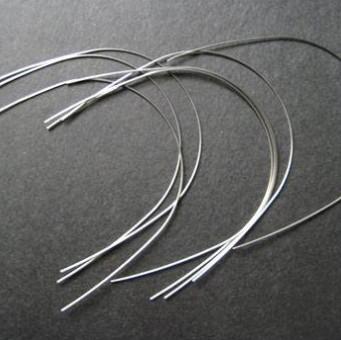
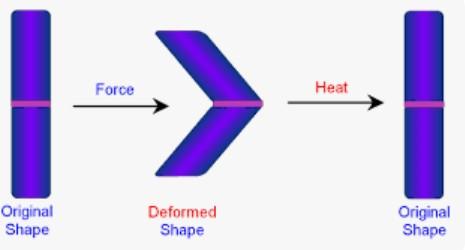

This inherent phase transformation is the basis for the unique properties of these alloys -- in particular, shape memory and super elasticity.
When a shape memory alloy is in its martensitic (extremely hard form of steel) form, it is easily deformed to a new shape. However, when the alloy is heated through its transformation temperatures, it reverts to austenite (a solution of iron and carbon) and recovers its previous shape with great force. This process is known as shape memory. This is when the external force is removed. This gives nitinol its rubber-like, springy properties. The highest temperature can withstand 1300 degrees Celsius and the lowest is –70 degrees Celsius.
Corrosion resistance: Nitinol is non-toxic and resistant to corrosion.
Biocompatibility: Nitinol is safe to use in medical devices.
Thermal conductivity: Nitinol has excellent thermal conductivity.
Ultimate tensile strength: Nitinol has a high ultimate tensile strength, making it solid and durable.
References:-
Links used:- How does Nitinol work? | MDC 13.12.24
https://www.sciencedirect.com/science/article/abs/pii/B97 80323911733000213 30.11.24
https://seisa.com/nitinol-wire-properties-applications-anduses/ 15.12.24

By Aryaman Sharma 7H
•Obesity is a growing tension, especially in the U.K. - rates are growing as they never had before, and parents are worried. The classification of obesity as a disease is a topic of ongoing debate among medical professionals and organizations, such as the AMA (American Medical Association) or the WHO (World Health Organization). They class it as a chronic disease, because of its abnormal and very weird interactions between genetic, environmental, and behavioral factors.
•It is prevalent in developed and developing countries and affects the daily life of children and of adults. It is so common nowadays that it overthrows the traditional public health concerns, such as malnutrition and infectious disease. Clinical evidence of obesity dates to Graeco-Roman times, but less understanding of the condition was made until the twentieth century.
•The condition is a chronic disease which directly means excessive fat deposits that can impair and damage health. Experts believe that as more obese children develop into obese adults, obesity-related diseases such as heart disease, cancer, and diabetes will become more widespread, therefore being deleterious to the population and leading to less overall military strength for one’s country.
•To avoid this, doctors recommend eating slowly and when hungry to prevent overeating. Limiting screen time is one other effective way to reduce risks of obesity – I know it might seem unrelated, but it has a secondary effect. By limiting screen
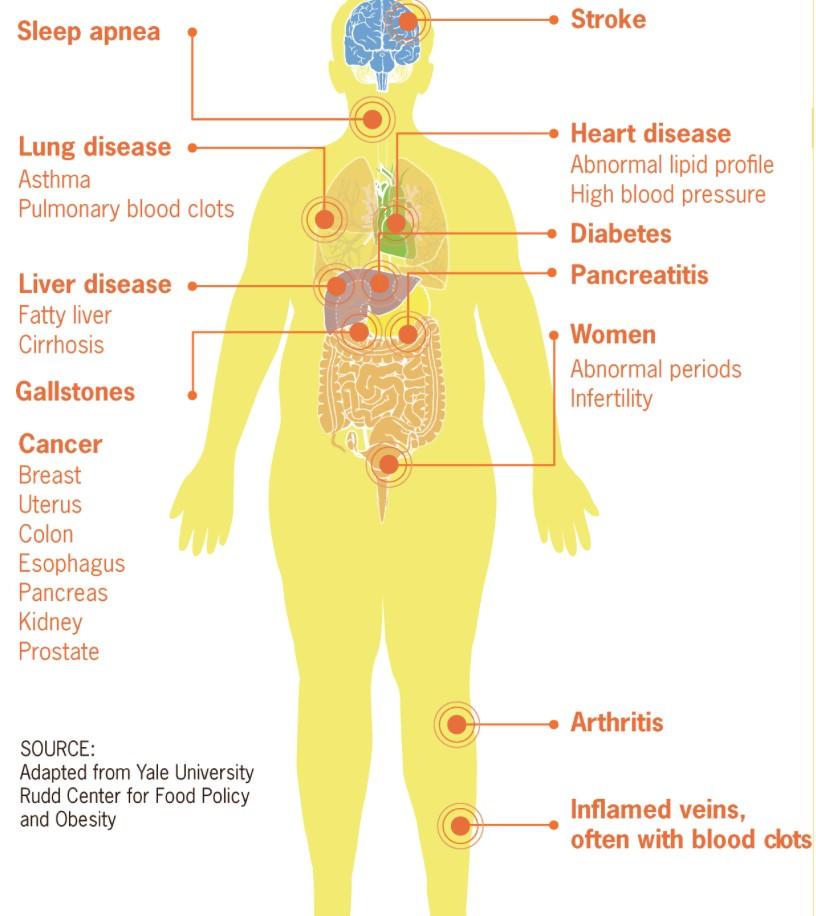
•Social and economic factors including experiencing poverty and the impact of long-standing structural racism and health inequities are strongly associated with obesity and are at the root of higher rates of obesity in low-income communities that have fewer resources to support healthy eating and being physically active, meaning this links to Sustainable Development Goal no. 5 and 10 (to end discrimination). that the United Nations wish to end.
•To conclude, medical professionals and organisations classify Obesity as a chronic disease, in which excess body fat accumulates to such an extent that it can have negative repercussions on one’s health.
•Quiz time!
•What does the WHO class Obesity as?
•From which time is Obesity traced back to?
•What SDG is related to obesity?
•What does Obesity directly mean?
•Thanks a lot for reading,
•Aryaman Sharma 7H
•Reference(s):
•(World Health Organization, 2000, Obesity: Preventing and Managing the Global Pandemic available at https://www.google.co.uk/books/edition/Obesity/AvnqOsqv9doC ?hl=en&gbpv=1&dq=Is+Obesity+a+disease&printsec=frontcov
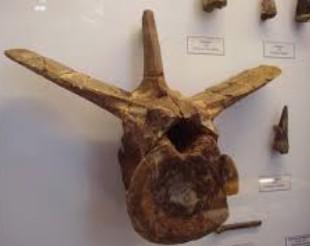

Paleontology: the science I'm glad to call my interest.
By Ahaan Sagar
Just about a month ago, I was in our school’s library when I saw a book. Micheal Chrichton’s Jurassic Park. I’m glad I decided to pick that book up. I couldn't put it down and now it has me hooked onto the fascinating science that I was once a stranger to. I’m glad that's not the case anymore. Like many of you I knew that dinosaurs and other creatures long predeceased us, but it's truly incredible that we know that, let me show you why.
The chances that any creature was to die in an area where for 65 million years, the weather conditions would be calm enough to let thousands of layers of rock to cover and preserve the bones is truly incredible. To put that into perspective, if you were to take 1 step every year, you could walk across the world and still have enough time to walk across the USA twice before your time was up, and if the weather conditions were bad at your starting point even once, you’d have to restart. That is incredible. Then we must dig in the right spot, in the right rock, to the right depth just to prove their existence. The first fossil of a dinosaur was that of a Megalosaurus and was found just a year after the great fire of London.
The importance of paleontology is undeniable, even in our modern-day world, where the extinct often doesn’t affect our lives. The learning about our far past teaches us about the earth’s seismic history and climates. The latter of which, is especially important in today's world, seeing as this is one of our most pressing problems today. Paleontology shows us how our ecosystems react to climate change and often proves helpful in predicting how the future of our earth will look. This field of study teaches humans about extinction and evolution and how us as a

I’m sure you know that Paleontology has shown us just how incredible and unique our world was millions of years ago. We have been shown the existence of all types of prehistoric birds; reptiles fish and more. I will briefly walk you through them.
The study of prehistoric marine life. This field of study has shown the existence of incredibly large, dangerous and frightening dinosaurs that have made an impact not only on science, but in modern media. I am talking about the Megalodon. Known for its size and predatorial behaviour and the characteristics to back it, this giant shark has featured in many movies and is now an integral part of modern media. Drifting away from media, marine life from prehistoric times has shown us lost about how our own fish that we call part of life will react to shocks to their systems of living. This is referencing to the plastic depositions into our oceans and knowing that past animals that called the oceans home found a way to live will tell us how we can help our own marine existence keep their existence alive
The study of extinct mammals is called paleontology. The specific study of these mammals is useful, this is because there are clear similarities between the creatures we know as bones and those that we know as living. There are close similarities between our living picture of fauna and the prehistoric one, especially in mammals. The woolly mammoth and the elephant are the most prominent of which. By looking at the changes in characteristics of an animal throughout a large period, we can dictate when threats must have come into existence and teach us about the way the food chain functioned in prehistoric times.
This field covers the study of reptiles, birds and amphibians. Many reptiles often resided in the sea; the most prominent water-dwelling reptile is the Mosasaurus. Known for its large almost crocodilian mouth and snout. A truly frightening and lethal creature. This is not to say that the birds posed any less of a threat. Pterosaurs were known for their ability to fly for, most likely, long periods of time to scout out and follow its prey until the right time to strike. Some pterosaurs had wingspans comparable to that of a jet and were known for their heartlessness, often feeding on baby dinosaurs. Amphibians were more various in their predatory capacity. On one hand there was the Beelzebufo, a large predatory frog that had a bite force like that of a tiger. On the other, the Ichthyostega wasn’t even able to walk and would fall prey to most everything the prehistoric world had to offer. I hope that you are no longer a stranger to this incredible field
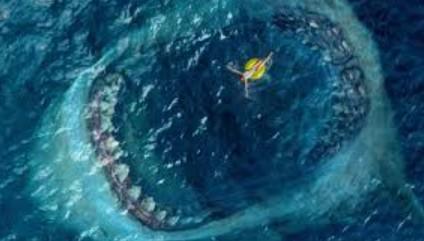

By Jebishan Jeseeyas, Nikhil Gajavilli, Avy Gowda
Psychology
Psychology is the fascinating study of the mind and behavior, and it helps us to understand why we do the things we do. Ever wonder why you get excited for a birthday or something you love? Psychology helps explain those emotions and actions. Did you know that Psychology derives from the Greek word psych which means mind and logia meaning reason?
Psychology plays a critical role in enhancing our understanding of mental processes behind human behavior, thoughts, and emotions. It allows us to understand ourselves and others, improving communication, mental health, and relationships. By reading this, you will learn to overcome stress, anxiety and how to take on daily challenges. Ultimately, psychological knowledge can help one make better decisions in life and create a healthier and more productive lifestyle independently by studying this topic.
•Why do we remember things differently from reality?
•Isn't it odd that our minds change the past? Our memories are not exactly on point, instead a replica shaped by various influences such as emotions and stress. When we attempt to recall an event, the brain recognizes gaps in memory and rewrites the past to fill in missing details, leading to confusion. For instance, if you are sitting a test and are stressed. You begin the test but suddenly cannot remember your revision and write something irrelevant. Why did this happen? Anxiety and stress create gaps in your memory causing your brain to be occupied with irrelevant information.
What area of our brain influences emotions and behavior?
The Amygdala is the part of the brain responsible for feelings, reactions and the way you behave. It is also responsible for tying emotional meaning to our memories. Additionally, your Amygdala tells you what to do in desperate times. If it is overstimulated, it will outweigh the logical parts of the brain. Therefore, keeping your emotions in check is crucial to avoid an” amygdala hijack.” This is when your emotions overpower your brain and may cause one to act irrationally.
A sixth sense?
We have all been taught that we have five senses, touch, taste, smell, hearing, vision and touch. However, there is considerable debate on there being more. For example, proprioception is our ability to track our body parts in space. If you were to close your eyes, you would still know where your arms are, even if you moved them. This is what proprioception is. Furthermore, you have heard the phrase,” Go with your gut.” We all have some sort of intuition or instinct inside us that tells us ideas without any evidence. That could be another sense.
To conclude...
In conclusion, this document has covered lots of different areas on the fascinating topic of psychology. Through describing parts of psychology, we have learnt what the amygdala is, why psychology is important and many more other factors of psychology. However, the mind is a very mysterious thing and there are still many more unanswered questions, but it is exciting to think about how much more we can learn about the human mind.
References
The picture of psychology in the first page is found on Google by the website Scientific Malaysian and the website is


Dharav Dalal 7C
Resuscitation is an extremely useful skill to learn, as it can save countless lives, anywhere you are. My experience of learning resuscitation was an extremely fascinating one, and I now know that I am ready to save a life if someone suffers cardiac arrest.
What is Resuscitation and Why is it important?
Resuscitation is when a person suffers a cardiac arrest, and another person must do CPR or use a defibrillator to shock the heart. This gives the heart a renewed chance of survival, therefore keeping the affected victim alive. By learning resuscitation, you can save the life of your fellow colleagues, or students.
It is important to learn this as again, you can save anyone’s life with this ability, as anyone can suffer a cardiac arrest anytime in their lives. This means that absolutely anyone can give CPR, and if you have any problems with your hands, then you can direct a person to give the CPR.
1. Make sure the area is safe before you enter.
2. Check if the patient is responsive or not.
3. Look, Listen and Feel if the patient is breathing or not, by looking for the rise and fall of their chest, feeling their breath on their cheek, and listening for breathing.
4. If the above is negative, put the patient on a flat surface, then call 999 and ask for the nearest defibrillator.
5. If you are alone, then put the phone on speaker; if there is someone with you, then ask them to call.
6. Once you have called, immediately begin 30 chest compressions about 4-6cm into the chest.
7. If you feel safe doing so, then give two rescue breaths to the patient.
8. Keep on this pattern (30:2) until the defibrillator arrives.
9. Follow the instructions on the defibrillator or hand over the patient to the paramedic(s) if they have arrived.
10. Once the defibrillator has arrived, then put the pads on the heart and midway down the axilla, and follow the steps given by the defibrillator.
11. Once the patient has been shocked, restart the 30 chest compressions.
For a Child
12. Do the above but chest compressions using a hill of ONE hand.
In my opinion, learning about resuscitation was a fascinating experience for me. Learning about the different ways in which you can perform CPR was extremely interesting, and the key fact, that CPR can be given by absolutely anyone was the main point. If everyone in the world knew how to perform CPR, countless more lives would be saved. This is the reason why I was willing to learn CPR, so that even one life saved could mean a lot to me, them, and that person’s family. I learnt:
13. CPR can be given by absolutely ANYONE.
14. A child can direct an adult to do CPR if their compressions are not strong enough.
15. Even if you do not properly follow the above guidelines, anything done can aid the survival of that patient.
By Dion Cristo 8B


You probably haven’t heard of maglev trains, but they are truly astounding. Maglev trains are a form of train that can reach shocking speeds of up to 600km/h. Despite these amazing statistics, they are only used in Japan, China and Korea.
In the year 1909, an American called Robert H. Goddard, a famous rocket scientist, suggested the possibility of magnetically levitated trains. This idea was developed by Eric Laithwaite and he patented linear motor induction, monorails are based on this. During the 1960s, this concept was refined and was brought up again by James R. Powell whilst stuck in traffic. He and Gordon T. Danby, with their existing skills in magnetic forces, created a design for the first modern maglev train.

How do maglev trains work?
You might be wondering how maglev trains can move so fast without derailing: they aren’t really connected to railway tracks. Maglev trains work by levitating because friction with rails will slow them down. There are magnets on the train as well as on the rails and because like magnetic poles repel, the train levitates as it is repelled away from the ground and pushes the train forward. On the other hand, opposite poles attract and pull the train forward. This creates a smooth experience for passengers due to the levitation and reduced friction.
In today’s world, global warming is getting worse than ever, and governments are looking to ecofriendly forms of transportation. Maglev trains could be a sustainable replacement for planes and cars and reduce journey times by a lot. It can boost the economy in the long term as it efficiently connects regions. They are also quieter than normal rail because maglev trains make less friction.
Northeast Maglev, 2018. Transportation Innovation: History of Maglev in the World [online]. Available at:
https://northeastmaglev.com/2018/09/25/transp ortation-innovation-history-of-maglev-in-the-wor ld/
[Accessed 10th December 2024]
US Department of Energy, 2016. How Maglev Works [online]. Available at:
https://www.energy.gov/articles/how-maglev-wo rks
[Accessed 10th December 2024] Wikipedia, 2024. Maglev [online]. Available at: https://en.wikipedia.org/wiki/Maglev#History [Accessed 9th December]
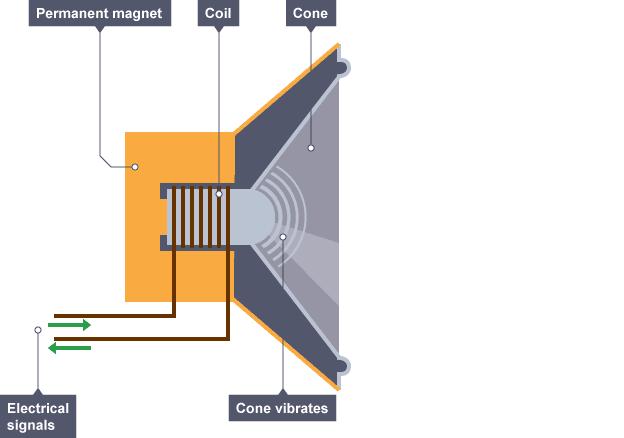

BY AJAY RAJ 8C
Sounds are vibrations, carried either by solids, liquids or gases. When an object vibrates, it sends sound waves through the air to our ears, which our brain understands as sound. Sound is used every day, however, unwanted sound damages health and well-being.
Sound waves have several important properties
Pitch: This describes how high or low a sound is. A tight drum skin produces a higher pitch than a looser one.
Frequency: This is the number of wave peaks and troughs that pass each second. Higher frequency means higher pitch.
Amplitude/Loudness: This measures how strong a sound is, from loud to quiet. Larger amplitude means louder sound.
Speed: How quickly the sound wave travels.
Reflection: Sound waves can bounce off surfaces.
Timbre: The unique quality of a sound that distinguishes different instruments or voices. These properties are typical of both transverse and longitudinal waves. Sound waves are longitudinal waves, which mean they consist of compressions and rarefactions within the medium they travel through.
When a sound reaches us, the air particles inside our ear canal vibrate and hit the eardrum. The eardrum then starts vibrating and these vibrations are then passed to three small ear bones – called the hammer, anvil and stirrup. The stirrup bone hits the cochlea, which turns the vibrations into an electrical signal that is sent to our brain via the auditory nerve. The brain then interprets these electrical signals as sound.
Hearing range describes the frequency range that can be heard by humans and animals. Frequency range is measured in hertz (Hz), which is the International System of Units (SI) for frequency. One hertz is equal to one cycle per second. Humans can hear sounds between 20 Hz and 20, 000 Hz, while some animals have a much broader range. For example, bats can hear sounds up to 200, 000 Hz. Even our pets can often hear sounds that we can’t.
Sound travels better in water than in air. Marine animals use sound for communication, hunting and exploring their environment. For instance, dolphins and some whale species heavily depend on sound. Sound waves can only travel through solids, liquids and gases because they need particles to vibrate. In a vacuum, there are no particles to vibrate. The arrangement of particles in these media affects how sound travels. Sound travels faster in denser materials. Sound waves travel slowest through gases, faster through liquids and fastest through solids.


•Reflection and Echoes
•Sound waves can reflect off surfaces. Flat surfaces reflect sounds better than rough ones. An echo is a reflected sound heard a short time after the original sound. Soundproofing materials like foam absorb sound waves and reduce echoes. A duck’s quack can produce an echo.
•The Speed of Sound
•The speed of sound depends on the medium it travels through. In air, sound travels at approximately 343m/s or 767 mph. In water, sound travels much faster, at about 5,399km/h (3,355mph). In a diamond, sound travels at an incredible 64,000 km/h (40,000 mph), which is more than 52 times the speed of sound in air or Mach 52. The average distance to the Moon is 238,855 miles. If sound could travel through a diamond-like material spanning this distance, it would reach the Moon in just about 6 hours. If sound was travelling through a liquid, it would reach the moon in roughly 71.2 hours. To put this into perspective, NASA’s New Horizon Probe, which holds the record for the shortest journey to the Moon, passed the celestial body in 8 hours and 35 minutes. The fastest manned aircraft, SR-71, reached speeds of up to Mach 3.3 or 2455.26 mph (3,951 km/h), 16.25 times slower than the speed of sound in a diamond.
•So, the answer? It really all depends on what it is travelling through.
•Applications of sound
•Sound has numerous important uses:
• Communications
• Healthcare diagnosis
• Music
• Signaling system
• Analyzing ocean depths
• Breaking down small particles
• Removal of gases from liquids
• Telephones
• Sterilization (kill bacteria)
• Tissue growth
•Bibliography
•The human ear and uses of sound waves guide for KS3
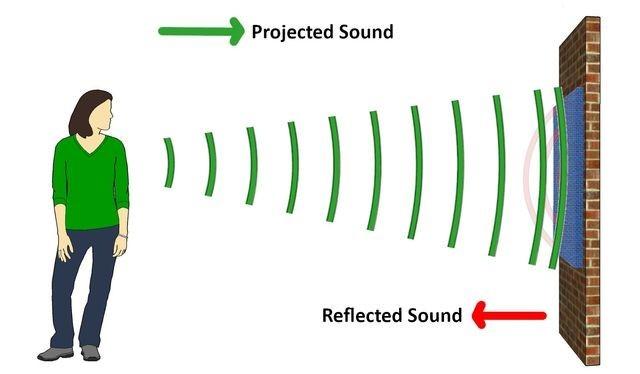
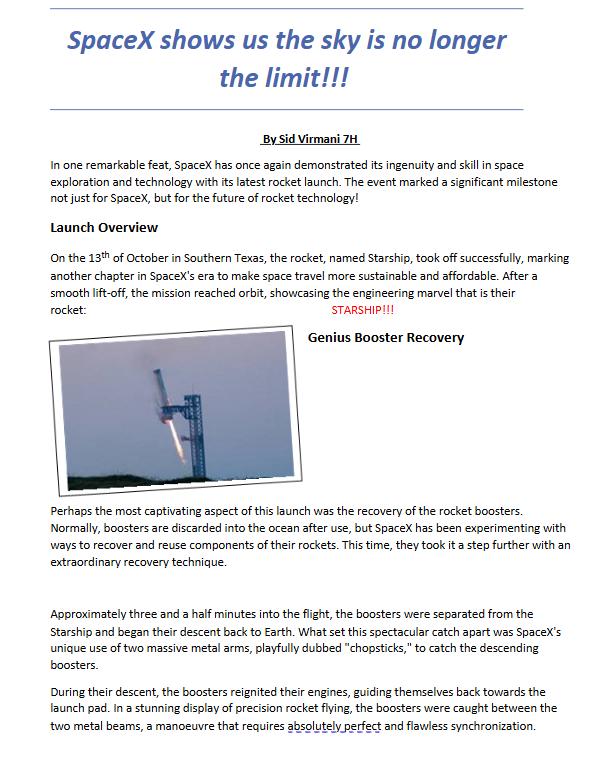



How did the Space Race revolutionise human space travel and exploration forever?
by Sarthak Mishra 8H
Introduction
At the end of World War II, the USA and USSR had been allies against the Axis powers, but ideological differences soon turned them into rivals. The US opposed Stalin’s harsh communist regime, while the USSR viewed American capitalism as exploitative. In 1947, President Harry Truman announced the Truman Doctrine, committing the US to support nations threatened by Soviet influence. This policy set the stage for the Cold War, a geopolitical struggle that would define the mid-20th century. Alongside this political battle, a technological and ideological competition emerged: the Space Race.
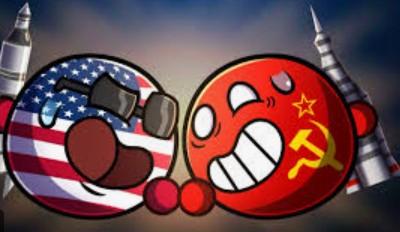


The US soon countered with the Gemini program, which aimed to master critical techniques like controlled spacewalks and orbital docking. In June 1965, Edward White conducted the first controlled spacewalk, lasting 23 minutes. His suit was a marvel of engineering, with a fiberglass helmet, gold-coated visor for radiation protection, and integrated communication devices. This mission demonstrated the precision and adaptability of NASA’s astronauts and engineers, bringing the US back into contention.
NASA (1961). April 1961 - First Human Entered Space - NASA. [online] NASA. Available at: https://www.nasa.gov/image-article/april-1961first-human-entered-space/ [Accessed 7 Jan. 2025].
Riley, P. (2021). Timeline of the Space Race | Britannica. [online] www.britannica.com. Available at: https://www.britannica.com/story/timeline-of-the-space-race.
The Planetary Society (n.d.). Yuri Gagarin and Vostok 1, the First Human Spaceflight. [online] The Planetary Society. Available at: https://www.planetary.org/space-missions/vostok-1.
Wikipedia Contributors (2019). Timeline of the Space Race. [online] Wikipedia. Available at: https://en.wikipedia.org/wiki/Timeline_of_the_Space_Race.




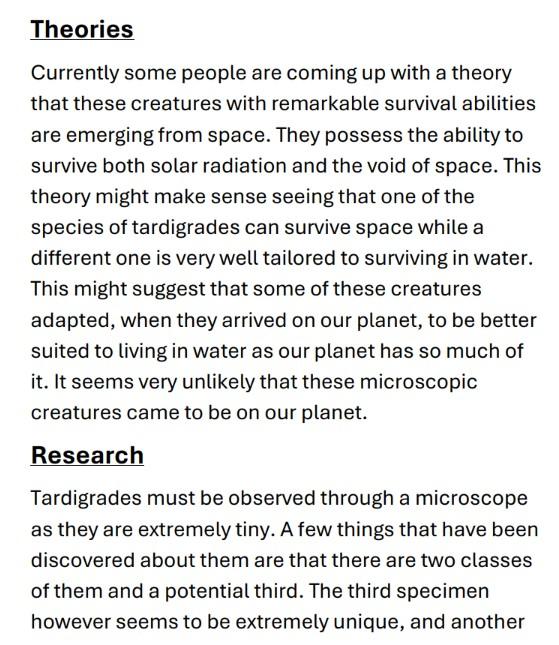

References:-
https://frontlinegenomics.com/everythi ng-you-need-and-want-to-know-about-t ardigrades/ https://youtu.be/eXBkmLzBHZk ?si=0NEsTDQt_mU7QB5G
YouTube video by AnimalogicTardigrades: The Most Resilient
Animals in the Universe
https://youtu.be/HsStKuWHI_c? si=6WDw5qnIFO-fJd-Z
YouTube video by Ze Frank-True
By Arjun Sharma 7L
Plants are one of the most important aspects of life on Earth. From small patches of grass in Algeria to tall trees in Brazil, they are home to approximately 80% of life on Earth and are the base of all ecosystems. Without plants, life as we know it would cease to exist as they are responsible for the producing the oxygen we breathe, providing the food we eat and keeping the balance in our environment.
One of the most essential contributions of plants to life on Earth is their role in producing which is crucial for most living organisms to live. Plants achieve this from a process called Photosynthesis, where they convert sunlight, water, and carbon dioxide into glucosea chemical compound which stores potential energy which cells can release and convert into useful energy - and oxygen that is released into the atmosphere and available for animals and humans to breathe. For example, the Amazon rainforest located in West Brazil is often referred to as the "lungs of the planet" because they produce a significant amount of the world's oxygen.
A food chain shows how plants and animals get their energy, enabling them to live and at the base of a food chain there is always a producer, which is usually a plant meaning they are the first source of energy for all other organisms. Plants are crucial for the planet we live in
Plants provide essential nutrients that sustain all life on Earth due to how the food chain works. They are rich in sources of vitamins, fibres and minerals which are crucial to maintain a healthy life for a human. For example, leafy plants such as spinach are high in iron and calcium and fruit like strawberries and oranges are high in vitamin C. Other plants such as lentils and beans are excellent plant-based protein sources, important for muscle repair and energy production while whole grains supply complex carbohydrates that fuels the body and support digestion.
Beyond direct consumption, plants play a key role in the diets of herbivores and omnivores which in turn support carnivores higher up in the food chain. Even processed foods often derive nutrients from plants, such as oils from seeds and sweeteners from sugarcane or corn. Plants are also useful for many medicines in the health industry significantly increasing the life expectancy of humans. Plants produce 98% of the oxygen we breathe and 80% of the food we eat.
In conclusion, plants are incredibly important for Earth and without plants the world we know would look drastically different. I hope this article will help you realize just how essential these miracles of nature are for us.
Reference materials:
https://www.bbc.co.uk/bitesize/articles/zss9msg https://planthealthaction.org/why-plants-are-important https://www.efsa.europa.eu/en/plh4l/role-plants



Hafid Mohamed
We use chemicals like fossil fuels to produce energy and that’s what we do to affect our world. The worst thing is that we still do it even though we know that it would affect the climate and damage ecosystems if we keep doing it. What it does is simple. While we produce energy from fossil fuels the waste produced from this is carbon dioxide. It is a very harmful gas that is a big contributor to global warming. There is something called the greenhouse effect which is where thermal energy emissions get trapped by carbon dioxide inside the atmosphere making the world hotter. This could eventually make the Earth devoid of life and it would be a planet which no one could settle on anymore.
Biodiversity generally refers to the variety and variability of life on Earth and is represented by the number of different species there are on the planet. Since its introduction, Homo sapiens (the human species) has been killing off entire species either directly (such as through hunting) or indirectly (such as by destroying habitats), causing the extinction of species at an alarming rate. Humans are the current cause of mass extinction. Human population will only be going higher and that means we will cause more extinction. If we don’t stop, whole ecosystems and animals will be wiped from the surface of this planet. This could cause many long-term problems to human population, like hunger and many more
Industry is an important part of the European economy, providing vital goods for modern life and jobs. At the same time, it is a source of great pressure on nature and on human health. Even though releases of pollutants by European industry have generally decreased over the last decade, the impacts and costs of pollution from industry remain high. There are ways that we are trying to stop the amount of carbon footprint that certain industries release. The company must spend money to legally manufacture. It means that the company must pay the government for the amount carbon footprint they make. This limits the amount that companies use because they don’t want to waste too much money. There was a law made in 2013 stating this.
It is quite easy to help our environment. We could help our environment just by planting trees and planting vegetables; more plants will help suck all the carbon dioxide via photosynthesis.
However, data shows we must also significantly decrease the emissions of carbon dioxide if we are to survive and stop climate change.
References

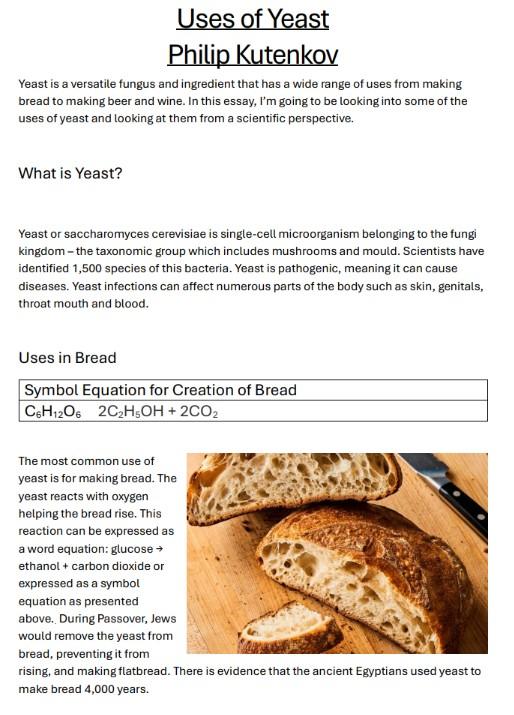
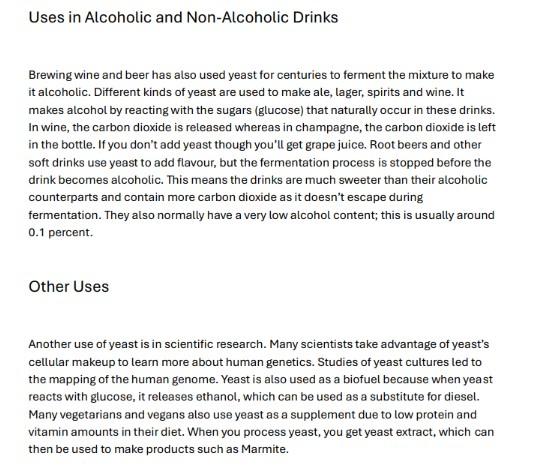
Bibliography
Live Science. 2013. What is Yeast? [online] https://www.livescience.com/42140-what-is-yeast-candid a.html
Accessed December 16, 2024
Sciencing. 2022. Common Uses of Yeast. [online] https://www.sciencing.com/common-uses-yeast-8217336/
Accessed December 16, 2024
Grapeworks. Date not Specified. Role of Yeast in Winemaking [online]
https://grapeworks.com.au/news/winemaking/the-role-of-
Writers and their articles:
Can we use genetics to prevent or cure diseases?, by Sparsh Bhadauria 8B
Carbon, by Karthikeya Turlapati 8C
Common Cold, by Eshaan Sharma 8H
Crystallisation, by SAIARPIT MISHRA 8L
The Ear, by Bavethran 8B
How Can Tardigrades Survive Ok? by Reyansh Gope, Mingyuan
Mi and Sarthak Mishra 8H
How does a plane fly? by Dharav Dalal 7C
Living outside the Earth, by Karthikeya Turlapati, 8C
Nitinol, by Anuran Kajentheran, Dev Jain and Dharav Dalal 7C
Obesity, by Aryaman Sharma 7H
Palaeontology, by Ahaan Sagar
Psychology, by Jebishan Jeseeyas, Nikhil Gajavilli, Avy Gowda 7H
Resuscitation, by Dharav Dalal 7C
The Science behind Maglev Trains, by Dion Cristo 8B
Sound, by Ajay Raj
Space X NKC, by Sid Virmani 7H
Space Race, by Sarthak Mishra 8H
The Survival of Tardigrades, by Vivaan Shanker
What Makes Plants So Important To Life On Earth? by Arjun Sharma, 7L
What we do to affect our world, by Hafid Mohamed 8H
Uses of Yeast, by Philip Kutenkov
Editors: Anuran Kajentheran
Rowan Arun Kumar
Vivaan Shanker
Eshaan Sharma
Organiser: Mrs Kim Bishop
Special Thanks to: The Science Department